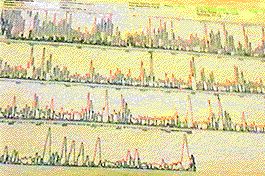The reconstruction of phylogeny - How is molecular evidence used?

Molecular characters
The logic of phylogenetic inference is identical for molecular and morphological characters, but the two have distinct properties and the methods and concepts used for each can appear very different.
Firstly, the distinction between homology and homoplasy is much less powerful for molecular evidence. Suppose a nucleotide is identical in two species. Evolutionary changes take place among a very limited set of alternatives (the four bases A, C, G, and T) and it is fairly probable that the same informational state could independently evolve in the two species. With proteins there are 20 amino acid states; but the same problem applies: 20 fixed states is a small number compared with the variety of morphological forms. Moreover, for molecules we usually lack the understanding between structure and function so we cannot calculate how natural selection can act on different pieces of molecular evidence.
For molecular sequences, therefore, it cannot be firmly established that an identical amino acid or nucleotide is homologous. All that can be observed is similarity: there is a chance that the similarity is homologous; but also a chance that it is homoplasious.
In this image, researchers at Harvard University are studying the DNA sequence of a Lycaenid butterfly.
| Next |



